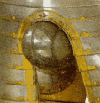Part the First
The codpiece has held a certain fascination, as well as other important items, for those of us involved with historical reenactment of the Renaissance. It has been regarded with fear and ignorance by many and a certain reverence by others. This discourse aims to dispel the fear and ignorance, and if you lack reverence, I can suggest a google search that will either help or turn you off wieners forever.
Codpieces were the first defining items of high fashion, having made their debut in the garden of Eden. These original codpieces were made of fig leaves, and seem to have been worn by both Adam and Eve. It is impossible to determine whose idea they were, but suspicions fall on the serpent, since at that time the codpieces were called, respectively, a “zucchini crisper” and a “muffin bin.”
Many have assumed that the “cod” in “codpiece” referred to a fish. Because of modern slang usage, or perhaps due to total loss of touch with reality, some have assumed that “piece” meant a firearm. Historically, the codpiece existed several decades before Leonardo da Vinci invented the fish-gun after eating too many special mushrooms in his cannelloni.
In Middle English, “Cod” (or “Codd” in Old English, “Coddd” in Exceedingly Old English) meant “bag” or “scrotum”, which led to some interesting moments when dining out at the Renaissance equivalent of Long John Silver’s. “This is the tastiest codd I’ve ever had in my mouth” was a guaranteed show stopper, bringing about numerous jokes and a homicide or two.
The medieval codpiece began as a flat piece of material covering the hot new thing in men’s clothing — a well placed slit. This new, “easy access” feature allowed men to relieve themselves while standing without lowering their pants or tights. Soon after this technological breakthrough, some wit coined the popular after ale phrase “Once more into the breeches.”
The simple flap was buttoned closed, laced closed, tied closed, or occasionally glued closed after a particularly exciting night at “The Yellowe Rose Publick Howse and Gentlemen’s Clubbe.”
Henry VIII and His Contributions
The codpiece remained flat cloth for a number of years. On a visit to Hampton Court, Duke Fabrizio of Bologna was enjoying an afternoon idyll between consenting adulterers, when he was called to the court. Dressing hastily after his interrupted interlude, the Duke employed the flap to contain his semiconscious nether parts while appearing before King Henry VIII and Queen Anne Boleyn.
Queen Anne, amused at the Italian’s conspicuous bulge, remarked “Be that thine codling or art thou glad to see me?” Of course, “codling” is 15th century English for either a “small, immature apple” or “any of several elongated greenish English cooking apples,” so we may never know if the Duke’s fruit was being ridiculed or complimented.
King Henry was distressed by the whole business and assumed this bulge (from Middle French “boulge” meaning “leather bag” or “curved part”, or perhaps “curved part in a leather bag”) to be the latest Continental style in courtly fashions. He immediately ordered his codpieces padded in order that he not look out of date by comparison to Duke Fabrizio, commanding, “My codpieces must compare favorably to Bologna.” Those tailors, very literal-minded fellows all, envisioned pork sausages and thus began the whole size contest that continues to this day.
Historical note: Catherine Howard, Henry VIII’s fifth wife, was executed in 1542 after only 2 years of marriage to the monarch. The real story behind her death is revealed here for the first time. Henry had returned weary and ill-tempered from a conference with Henri II, king of France, where they had argued about the ownership of Normandy and how to spell “Henry.” Catherine lost her head both figuratively and literally when she pointed to Henry’s newest and largest codpiece, smiled wryly, and tittered, “Compensating much?”
The End of an Error
The codpiece fell from popularity in the 17th century with the rise to power of the puritan movement. As the puritans gained control across Europe and most especially in England, they enacted harsh and sweeping laws intended to remove all traces of sexuality, music, dancing, theater, and vegetables not boiled to mush.
Codpieces paused in their long slide to sartorial irrelevance in 19th century London. They re-emerged briefly as a so-called “Victorian Secret,” for clandestine sale alongside fellow feature enhancers including the bum roll, the peascod stomach and the Bosom Enhancer of Miracles.
The codpiece made only the briefest of comebacks in 1941 during a photo shoot for “Week-End in Havana.” Cesar Romero, known for being quite the joker, snatched a banana from Carmen Miranda’s headdress and dropped it in his fanny pack. Carmen acknowledged that the impromptu banana codpiece “certainly has appeal,” (we will never know if she admired it or was just stating the obvious) just before her panties disintegrated. Neither Cesar, who was gay, nor his banana rose to the occasion.
Warning to historical reenactors looking to purchase a codpiece to complete their costumes: while it may resemble one in certain particulars, the so-called “strap-on” is not a codpiece. As such, it should be avoided for recreation of historical events, although it may well invigorate recreation within the bedroom, throne room, or maid’s quarters.
 |  |  |  |
| Common or “bologna” codpiece | Egg-shaped or “huevos rancheros” codpiece | Be-ribboned or “foofy” codpiece | Armored or “sausage o’ steel” codpiece |
Coming in Part the Second
More word origins – What happened when the codpiece of King Richard III (Dick to his friends) came unbuttoned.
